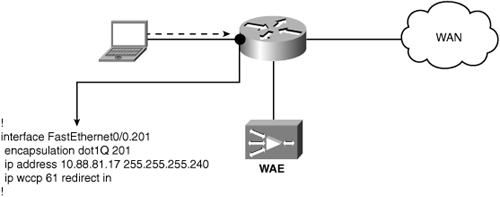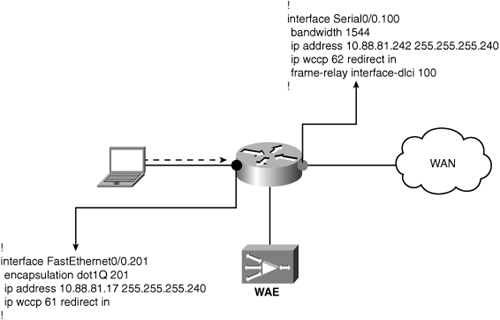WCCP Service Groups
The routers and WAEs participating in the same service constitute a service group. A service group defines a set of characteristics about what types of traffic should be intercepted, as well as how the intercepted traffic should be handled. There are two types of service groups:
- Well-known services
- Dynamic services
Well-known services, also referred to as static services, have a fixed set of characteristics that are known by both IOS and WCCPv2 client devices.
There is currently a single well-known service called web-cache. This service redirects all TCP traffic with a destination port of 80. The characteristics of a dynamic service are initially only known to the WCCPv2 clients within the service group. The characteristics of the service group are communicated to the IOS devices by the first WCCPv2 client device to join the service group.
A unique service ID identifies service groups, which is a number from 0 to 255. Service IDs 0 to 50 are reserved for well-known services.
The WCCPv2 implementation in WAAS supports a single dynamic WCCPv2 service, the tcp-promiscuous service. Although referred to in WAAS as a single service, the tcp-promiscuous service is in fact two different services:
- The two service IDs enabled with the tcp-promiscuous service are 61 and 62. These are the two service group IDs that are configured in IOS when using WCCPv2 with WAAS.
Two different service groups are used because both directions (client-to-server and server-to-client) of a TCP connection must be transparently intercepted.
- To optimize a connection, WAAS must see both directions of the connection on the same WAE.
Not only does WAAS intercept the connection in both directions, but it also intercepts the connection on both sides of the WAN link. Because the packet Layer 3 and Layer 4 headers are preserved, transparent interception is used on both sides of the WAN in both directions to redirect connections to the WAAS infrastructure for optimization
What is the difference between services 61 and 62?
You can view the service attributes using CLI commands in both WAAS and IOS. Example 4-9 shows the attributes of services 61 and 62 using the IOS CLI:
AST6-RTR-02# show ip wccp 61 service
WCCP service information definition:
Type: Dynamic
Id: 61
Priority: 34
Protocol: 6
Options: 0x00000501
--------
Hash: SrcIP
Alt Hash: SrcIP SrcPort
Ports: -none-
AST6-RTR-02#
AST6-RTR-02# show ip wccp 62 service
WCCP service information definition:
Type: Dynamic
Id: 62
Priority: 34
Protocol: 6
Options: 0x00000502
--------
Hash: DstIP
Alt Hash: SrcIP SrcPort
Ports: -none-
AST6-RTR-02#
WCCP Service Group Attributes
| Value | Description |
| Type | Well-known or dynamic service. |
| Id | The numeric service ID for the group. |
| Priority | The priority for the service group. When multiple service groups are configured on the same interface in the same direction, they are evaluated in descending priority order. |
| Protocol | The IP protocol number defined by the service group. |
| Options | Flags field indicating further service characteristics. |
| Hash | The value(s) in the redirected packet used as the hash key. |
| Alternate Hash | The value(s) in the redirected packet used as the alternate hash key. |
| Ports | The Layer 4 port numbers defined by the service group. |
The command output shows that the only difference between services 61 and 62 is the value from the packet used as the hash key. By default, service group 61 hashes on the source IP address and service group 62 hashes on the destination IP address.
PLACEMENT OF SERVICE GROUPS
The placement of service groups 61 and 62 should not be overlooked in your deployment. The placement refers to which IOS interfaces are configured with service group 61 and which interfaces are configured with service group 62. In most environments, service group 61 should be configured on the client-facing interfaces. For example, when deploying WCCPv2 on a remote-office WAN router, service group 61 is configured to intercept a client request. Configuring group 61 inbound on the router’s LAN interface or outbound on the router’s WAN interface accomplishes this.
An example of configuring service group 61 inbound on the router’s LAN interface:
For the reverse direction of the connection, service group 62 is used. Service group 62 will be configured in the opposite direction of service group 61. Using the same example shown in the diagram above, which shows service group 62 configured inbound on the router’s WAN interface. The following figure shows the complete placement and configuration using both service groups:



